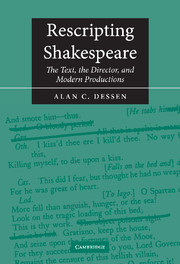Book contents
- Frontmatter
- Contents
- Acknowledgments
- Note on documentation
- List of abbreviations
- 1 “Let it be hid”: price tags, trade-offs, and economies
- 2 Rescripting Shakespeare's contemporaries
- 3 Adjustments and improvements
- 4 Inserting an intermission/interval
- 5 What's in an ending? Rescripting final scenes
- 6 Rescripting stage directions and actions
- 7 Compressing Henry VI
- 8 The tamings of the shrews: rescripting the First Folio
- 9 The editor as rescripter
- Conclusion: what's not here
- Appendix: productions cited
- Notes
- Index
7 - Compressing Henry VI
Published online by Cambridge University Press: 22 September 2009
- Frontmatter
- Contents
- Acknowledgments
- Note on documentation
- List of abbreviations
- 1 “Let it be hid”: price tags, trade-offs, and economies
- 2 Rescripting Shakespeare's contemporaries
- 3 Adjustments and improvements
- 4 Inserting an intermission/interval
- 5 What's in an ending? Rescripting final scenes
- 6 Rescripting stage directions and actions
- 7 Compressing Henry VI
- 8 The tamings of the shrews: rescripting the First Folio
- 9 The editor as rescripter
- Conclusion: what's not here
- Appendix: productions cited
- Notes
- Index
Summary
“Commanded always by the greater gust”
3 Henry VI, 3.1.88When dealing with Shakespeare's Henry VI on the page or on the stage, a critic, an editor, or a director immediately confronts the question of the integrity of the three plays as they have survived in the 1594 Quarto of Part II and the 1595 Octavo of Part III (among the earliest of Shakespeare's works to appear in print) and the First Folio (where Part I first appears). Since the eighteenth century, scholars and theatrical professionals have shown little confidence in or enthusiasm for these histories as intact entities, worthy of analysis as discrete units, but rather have either lumped them together as one item that can be dealt with summarily or raided them so as to appropriate detachable elements that suit the interpreter's agenda. As noted in chapter 3, directors often graft Richard of Gloucester's speeches from Part III onto Richard III; several scholars have written tellingly about Joan de Pucelle; and other distinctive parts have been singled out for attention or analysis, with one line (“The first thing we do, let's kill all the lawyers” – Part II, 4.2.76–77) achieving a cult status. Admittedly, starting in the 1960s and 1970s a few academic critics have argued forcefully in behalf of thematic or imagistic integrity; at least three directors (Terry Hands, Jane Howell, Michael Boyd) have treated the scripts with respect.
- Type
- Chapter
- Information
- Rescripting ShakespeareThe Text, the Director, and Modern Productions, pp. 166 - 184Publisher: Cambridge University PressPrint publication year: 2002

